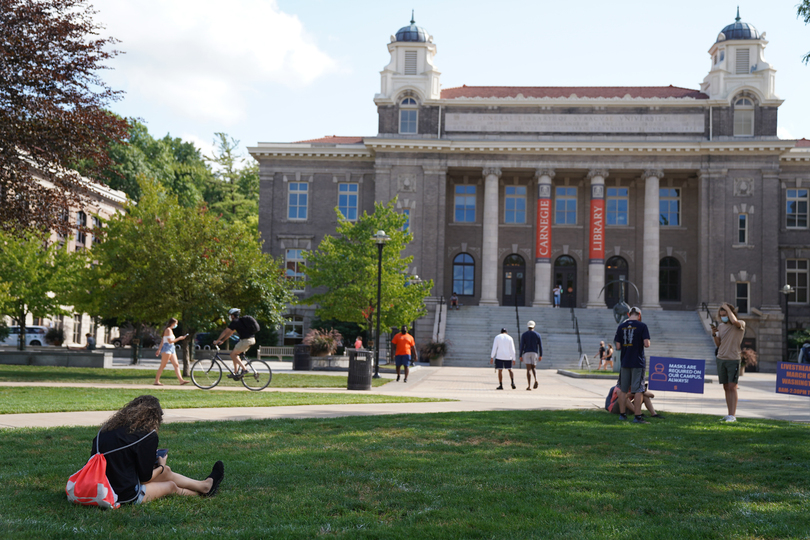It’s time to accept and embrace neurodiversity in our society

This Autism Awareness Month, we should celebrate neurodiversity instead of continuing to stigmatize it. Emily Steinberger | Editor-in-Chief
Today, the neurodiversity movement is one of social justice, acceptance and human rights. It is not exclusive to any single disorder; instead, it strives to be inclusive of anyone outside of the “neurotypical” or “NT” label. Those with disorders such as attention-deficit/hyperactivity disorder, obsessive-compulsive disorder and many others are considered “neurodivergent” or “ND.” One important community at the forefront of the neurodiversity movement are those with autism spectrum disorder, also referred to as ASD.
The National Institute of Health defines ASD as “group of neurodevelopment disorders that affect how people communicate, learn, behave, and socially interact,” with spectrum referring “to the wide range of symptoms, skills, and levels of disability in functioning that can occur in people with ASD.”
While defunct standards attempt to divide ASD into groups based on level of function, researchers and doctors have a difficult time defining “poles” of the spectrum. Some doctors have now started thinking of the autism spectrum as more of a circle, similar to a color wheel.
Considering recent research into ASD, it’s important to move beyond the high and low-functioning labels and the presumptions or stereotypes associated with them. These terms create unrealistic expectations and belittle otherwise capable people. Some may be incorrectly labeled as low-functioning because they are nonverbal, but are excellent communicators when given the proper accommodations. Other individuals may have really high IQs, but struggle to perform in a typical work environment due to focus issues or overstimulation.
Beyond mislabeling, people with ASD face a lot of other stigmas. Miseducation has led to the public looking down upon those with ASD. Organizations such as Autism Speaks further spread this stigma through its advertisements and the ways in which it speaks about autism, comparing it to terminal illnesses and calling it a destroyer of marriages. It has funded research into the identification of genes related to ASD, seeking a “cure” rather than providing support. This constant search for a “solution” ignores the importance of neurodiversity in humanity.
Simon Baron-Cohen, the director of the University of Cambridge’s Autism Research Centre, speaks directly on the importance of ASD in the current neurodiversity of humanity. “It happens that inventors and autistic people both love to repeat their observations of such patterns, over and over again, to uncover timeless laws,” he writes, also saying that “autistic people have really contributed to human progress, to why we are the dominant species on the planet.”
The movement for neurodiversity is also supported by recent studies into the neurodivergent brain. When considering the labeling of autism, Baron-Cohen notes, “The term ‘disorder’ implies the natural order has gone awry” but “when we examine the cognition and biology of autism, arguably what we see is not evidence of dysfunction but rather evidence of difference.”
How, then, do we move beyond the stigma surrounding autism to create a society more accepting of the natural differences in the brains of those with ASD?
One option is to start listening to those with ASD when it comes to their own “disorder.” At its heart, Baron-Cohen argues, “the notion of neurodiversity is very compatible with the civil rights plea for minorities to be accorded dignity and acceptance, and not to be pathologized.”
Those with ASD have a far more personal experience with autism than those who think they know about it. While scientists may believe they have an understanding, research suggests “autistic adults should be considered autism experts and involved as partners in autism research.”
As Elizabeth Picciuto of The Daily Beast argues, those with ASD recognize the importance of a mindset that moves away from “changing autistic people so that they fit into a narrow stripe of acceptable behavior in the world” and rather would “like to see the world expand its concept of acceptable behavior to include people with autism.”
Schools and universities nationwide should engage in efforts to combat the continued stereotyping of the ASD community. Education about autism should begin in grade school, and it should be described not as a dysfunction, but rather as a natural difference in neuroanatomy.
Further opportunities to destigmatize ASD must be approached in larger communities and throughout society. The dismantling of groups such as Autism Speaks — regarded by many in the ASD community as a hate group — would be an excellent start. Neurotypical people in charge of funding research into ASD need to be reeducated or removed. Their constant search for a cure ignores cries for acceptance, sending money into gene research rather than into support for those living with ASD.
Neurodiversity, at its core, is not so much about changing how the world behaves, but rather asking the rest of the world to accept the different, natural behaviors of those with ASD and other so-called “disorders.” Advocates ask not for a cure, but for acceptance.
Julia Bascom, executive director for the Autistic Self-Advocacy Network, says, “The idea of a cure for autism doesn’t make sense. Autism isn’t a disease or an injury; it’s a neurodevelopmental disability that shapes our brains differently.”
It is time for the world to embrace the neurodiversity movement and accept those with ASD as full members of our society, rather than lesser beings.
If you’re looking for a charity or organization to support, check out organizations run by autistic people like the Autistic Self-Advocacy Network, AWN Network and Autistic Inclusive Meets.
Kiersten Edwards, Class of 2023





